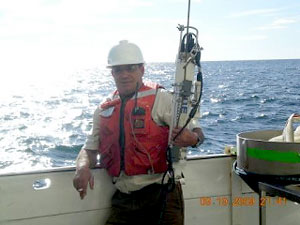|
|
Journals 2009/2010
Beth Brocato
Exeter-West Greenwich Junior High School, W. Greenwich, Rhode Island
"Bottom Trawl Survey, Northeast Fisheries Science Center"
NOAA ship HENRY B. BIGELOW
September 9 - 24, 2009 |
 |
 |
Journal Index:
September 9 - 10 - 11 - 12 - 13 - 14 - 15 - 16
17 - 18 - 19 - 20 - 21 - 22 - 23
24
|
September 20, 2009
Other science research
Track the Bigelow.
In conjunction with the fish study, the scientists aboard this ship are also collecting evidence of much smaller organisms. These would be plankton. Before we tow at a particular station a pair of "bongo nets" are put in the water to collect evidence of zooplankton - marine animals too small to be seen with the naked eye.
 |
The pair of bongo nets collecting plankton samples. A pulley with a cable is used to lower the nets into the water column. A collecting bucket, attached to the net is used to contain the zooplankton sample. Finally, when the net is retrieved from the ocean, the collecting bucket can then be detached and the specimens stored in small bottles to be examined by microscope at a later time. |
When sampling plankton, scientists are attempting to answer two questions:
- What living organisms does the sea contain at a given time?
- How does this material vary from season to season or year to year?
Another measurement taken before each tow is called "CTD." The CTD device measures Conductivity, Temperature and Depth at a particular location. Conductivity and temperature are used to determine the salinity (or how salty the water is). The CTD data, in conjunction with the plankton samples and fish count give a whole picture of the quality of the marine environment at a particular time and place.
 |
This is Tony, one of the crew, about to deploy the CTD. |
|
|




